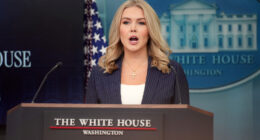
Just how much have American politics shifted after the end of Roe? Not as far as some have speculated. As progressive rage against the Supreme Court escalated in the streets of Washington DC and elsewhere, calls have come for Joe Biden to embrace the court-packing schemes that activists advanced after his election, and to which Biden at least pandered initially.
No time like the present, argued Nina Totenberg yesterday, declaring that the Supreme Court had “spent all its political capital”:
.@NinaTotenberg in @NPR special coverage: “In this decision, the court spent ALL its political capital.” …
“The idea of adding Supreme Court justices, which I thought didn’t have a leg to stand on,
I think at some point may have traction.”— Domenico Montanaro (@DomenicoNPR) June 24, 2022
Rep. Alexandria Ocasio-Cortez (D-NY) also renewed her call for expanding the court and allowing Biden to fill enough slots to return control back to progressives:
Rep. Alexandria Ocasio-Cortez (D-NY), who has long advocated adding additional justices to the court, told CNN she stands by that call.
“Not only should we look at expanding the Supreme Court, but I think we need to acknowledge that the Supreme Court of the United States has very few checks and balances,” she said.
It didn’t take the White House long to throw a deluge of cold water on that idea. Rather than pander for a while and then push off the idea onto a commission for more study — Biden’s strategy last year — the White House opted to nip this idea in the bud immediately.
The White House today on calls to expand the Supreme Court: “That is something that the President does not agree with. That is not something that he wants to do,” Karine Jean-Pierre says aboard Air Force One
— Kevin Liptak (@Kevinliptakcnn) June 25, 2022
So who exactly has spent all of their political capital?
The speed in which Biden and his team shot this down is more remarkable than the position itself. Biden tacitly wound up opposing Supreme Court expansion when his judiciary fact-finding commission ended only offering a weak argument for term limits while noting even that would require a constitutional amendment. Expanding the court, they found in their December report, lacked anywhere near the political support required to succeed in Congress, and even among their own members:
READ RELATED: That Biden cheat sheet was apparently real
The commission also concludes that Congress has broad authority to increase the number of justices but takes no position on expansion, noting the “profound disagreement among commissioners on this issue.”
A few weeks later, the Washington Post noted that even the term-limits idea was a political loser:
President Biden’s commission to study structural revisions to the Supreme Court found one potential change both Democrats and Republicans have said they could support: implementing term limits for the justices, who currently have lifetime tenure.
Yet the bipartisan support among legal experts and the public for term limits isn’t catching on among elected officials on Capitol Hill who would be the starting point on any alterations to the makeup of the Supreme Court. Impatient liberals clamoring for change say enacting term limits would take far too long, while Republican lawmakers are loath to endorse changes they are characterizing as part of a broader effort from Democrats to politicize the judiciary.
The opposition from both corners adds another layer of doubt that proposals laid out and debated by Biden’s Supreme Court commission will translate into tangible action in the near future.
It took most of Biden’s first year in office to finally kinda-sorta take a position that didn’t so much oppose court-packing as it did ignore it. Today, however, just as Jean-Pierre busily claims that Biden’s casting a wide net for “solutions” to Roe‘s demise, the White House is making damned sure to let everyone know that a structural overhaul of the Supreme Court isn’t among them. Why?
It’s always risky to give any credit to this White House for strategic thinking, but the commission and the massive but brief eruption of outrage over the Dobbs leak may have taught them a lesson: Progressive activists don’t have the pulse of the electorate after all. The supposed groundswell of demand for court-packing turned out to be mainly limited to academics and the aforementioned activists. The Dobbs leak inspired a lot of performative outrage, but the then-presumed end of Roe and Biden’s own performative outrage over it didn’t move the polling needles at all. It didn’t lift abortion to the top or even the intermediate range of issues in this election cycle. Even the small bump that did occur was marginal and diminished not long after the leak. And in the NBC News poll conducted the week after the leak, Republicans actually scored better on abortion (35/46) than Democrats (31/50).
The White House probably looked at that track record and decided to keep from talking about radical solutions. If so, it may have been their smartest move in months, but it will still anger the progressive activists in the party and diminish their enthusiasm even further for Biden and midterm Democrats. Choosing the better of two bad options doesn’t mean you gain anything — it just means limiting the damage, and that appears to be what Biden’s team is hoping to accomplish.
The best way to look at the political impact of Dobbs is in twos: two days, two weeks, two months, and two years. Over the first couple of days, we can expect a deluge of media attention to the ramifications of the end of Roe, and we’re already seeing wall-to-wall heartstring-pulling narratives over the lack of abortion access. That will drive attention to the issue in the first few days, which means that we can expect a polling response to it over the next couple of weeks. Those polls may initially hurt the GOP’s generic ballot position, but are not likely to help Biden much either.
However, the plain fact is that American households do not live immersed in the abortion issue. They do find themselves immersed in inflation, high gas prices, shortages at the grocery stores, and the resultant erosion of their buying power. Rapid increases in crime is also a daily lived experience for American voters in urban and first-ring suburban communities. Americans do not visit the abortion clinic every week, but they do fill their tanks and buy food and other essentials on a weekly basis. Over the next two months or so, and likely sooner if the political dynamics of the Supreme Court leak play out again, abortion will once again fade to a background issue while voters focus on the economy, inflation in particular, and crime. And to the extent that violent protests and attacks on crisis pregnancy centers start dominating the news, it will make the crime issue even more relevant — and that won’t help Democrats at all. By the end of summer, and likely well before that, the impact of Dobbs on the midterms will likely have been entirely dissipated.
In two years, though, it might be a different story. Republicans got a lot more traction out of the Supreme Court/judiciary argument in presidential cycles than Democrats did before Dobbs. That could change, unless state legislatures and/or Congress act to craft rational abortion-access policies that represent the broad middle in each state and/or the nation in the vacuum left by Roe‘s demise. If the economy has returned to health and energy prices fall, abortion and whatever unresolved aspects of abortion policy remain may become more important in the minds of voters. Republicans failed in 2018 to comprehend how important health care became as a midterm issue once the economy really fired up in the previous year, for instance. As Allahpundit noted yesterday, the House GOP effort to craft a centrist federal policy on abortion access may cause a gnashing of teeth among pro-lifers — including myself, I might add, on both policy and the need to leave this issue to states — but it might be a prophylactic to any potential backlash in the presidential cycle.
We’re still a long way off from those considerations, and that is predicated on a large economic if, considering the incompetence of this administration. That alone will sideline abortion as a key voter issue as long as the inflationary and/or recessionary environment continues, except among those who are already single-issue voters on abortion. And it looks like the White House realizes that.
Source:






